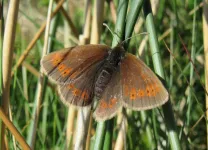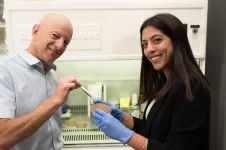(Press-News.org) UK landowners and conservationists welcome wider-spread use of Gene Conservation Units (GCUs) to help protect some of the rarest plants and insects, research at the University of York has shown.
In particular the Great Yellow Bumblebee and the Mountain Ringlet Butterfly, which are at risk of further population decline, would benefit from Gene Conservation Units, currently only employed for forest trees and agricultural species or their relatives.
Genetic diversity in these species is essential if they are to adapt to new, and often challenging, environmental conditions. Gene Conservation Units are areas of land managed to allow the recovery of species, and maintain evolutionary processes to enable them to adapt to environmental change.
For tree species, this means promoting natural regeneration, and for others, it means ensuring that the breeding population is large enough, and diverse enough, to be able to weather the changes ahead. Habitat management may achieve this, as well as population monitoring to ensure a large population is sustained.
PhD researcher Melissa Minter, from the Department of Biology at the University of York, said: "In investigating whether landowners would be interested in adopting a system of GCUs, we looked at the potential benefits these might bring to some species of insects and plants.
"We have shown that the genetic diversity of cold-adapted butterflies, such as the Mountain Ringlet, is at high risk of local extinction in a warming climate and so conservation measures are needed to secure the survival of threatened populations.
"Similarly, the Great Yellow Bumblebee now only survives on a few Scottish islands and the northern tip of mainland Scotland, which means that any changes in our climate could negatively impact their already depleted population.
"We wanted to know if GCUs could provide a solution to some of these issues and whether this concept could be applied to other species, in addition to forest trees."
The research involved a survey questionnaire of conservationists and land managers to gather opinions on adopting a system of GCUs to protect biodiversity. The survey results showed that if GCUs could be co-developed with stakeholders, then a GCU approach is more likely to appeal to land managers.
Specifically, landowners would benefit from setting-up GCUs on their land as recognition of best practice in conserving species and genetic diversity, and supporting evolutionary processes to help species cope with environmental change. A working group has now been established to look at how the first non-tree GCU could be developed.
NatureScot's Beinn Eighe National Nature Reserve (NNR) was registered as the UK's first GCU in recognition of its ancient Caledonian pine forest in 2019. Since then, the Woodland Trust have registered several more sites across the UK, including three more in Scotland, for six tree species.
NatureScot Woodlands Officer and research co-author Jeanette Hall said: "We have seen first-hand how successful the Gene Conservation Unit approach can be with the registration of our Beinn Eighe NNR and this research shows the exciting potential for working with land managers to expand this work to cover many more plant, animals and wild species.
"Conserving genetic diversity remains an international biodiversity priority so in what will be an important year for nature and tackling climate change, it's great to see partnership working across the UK leading the way in this field."
Genetic diversity was the focus of one of the international Aichi 2020 biodiversity targets. This year new global targets to improve nature will be agreed at a Conference of the Parties in Kunming, China (COP15), followed by the COP26 on climate change in Glasgow.
INFORMATION:
The research team is now looking at establishing two GCUs in Scotland and will monitor the success of GCUs in supporting at-risk species.
The study, published in the journal, Ecological Solutions and Evidence, is supported by NatureScot, the Natural Environment Research Council (NERC), University of York, Forest Research, and the University of Edinburgh.
FRANKFURT. When the SARS-CoV-2 virus mutates, this initially only means that there is a change in its genetic blueprint. The mutation may lead, for example, to an amino acid being exchanged at a particular site in a viral protein. In order to quickly assess the effect of this change, a three-dimensional image of the viral protein is extremely helpful. This is because it shows whether the switch in amino acid has consequences for the function of the protein - or for the interaction with a potential drug or antibody.
Researchers at Goethe University Frankfurt and TU Darmstadt began networking internationally from the very start of the pandemic. Their goal: to describe the three-dimensional structures ...
Thousands of sharks have been illegally caught in a Marine Protected Area (MPA) in the Indian Ocean, new research shows.
The MPA was created in 2010 around the Chagos Archipelago, also known as the British Indian Ocean Territory (BIOT), banning all fishing there.
The new study examined information on illegal fishing in the MPA - a vast (640,000 km²/250,000 mi2) area containing pristine and remote reefs.
Enforcement data suggests more than 14,000 sharks were caught in the MPA from 2010-20, but discussions with fishers in the region suggest the true number was "considerably ...
BEER-SHEVA, Israel May 10, 2021 - Researchers from Ben-Gurion University (BGU), together with American and German colleagues, have developed new "molecular tweezers" to combat antibiotic-resistant bacteria. Their recently announced findings were published in Cell Chemical Biology.
For years, medical professionals have struggled with bacterial infections becoming increasingly resistant to antibiotics. These molecular tweezers may be the key to battling one of greatest public health issues of the 21st century.
"Our discovery prevents infection without building up antibiotic resistance, and it might even be preferable to develop treatments based on molecular tweezers rather than antibiotics," said BGU Department of Chemistry Prof. Raz Jelinek.
The research team, led ...
Bamboo cricket bats are stronger, offer a better 'sweet spot' and deliver more energy to the ball than those made from traditional willow, tests conducted by the University of Cambridge show. Bamboo could, the study argues, help cricket to expand faster in poorer parts of the world and make the sport more environmentally friendly.
"The sound of leather on willow" may have delighted cricket lovers for generations but the sport should now consider making the blades of its bats with bamboo, say researchers from Cambridge's Centre for Natural Material Innovation. ...
A group of UK academics are calling for targets for mental health in order to meet the healthcare challenges of the next decade.
Published today in Journal of Mental Health researchers set out four overarching goals that will speed up implementation of mental health research and give a clear direction for researchers and funders to focus their efforts when it comes to better understanding the treatment of mental health.
The treatment of mental illness currently brings substantial costs to not only the NHS, but also to the individual and wider society, and the need for innovation to promote good mental health has never ...
New research being presented at the European Congress on Obesity (ECO) held online this year, suggests that among girls a low body mass index (BMI) during childhood indicates a higher risk of developing anorexia nervosa as young adults, whereas a high BMI or overweight in childhood indicates a higher risk of bulimia nervosa.
"By examining the records of thousands of girls over their lifetime in national health registers, we have discovered early warning profiles that could signal girls at risk for anorexia nervosa and bulimia nervosa", says lead author Dr Britt Wang Jensen ...
New research being presented at The European Congress on Obesity (ECO) held online this year, suggests that a measure of body shape should be used alongside body mass index (BMI) to help determine the risk of obesity-related cancers.
BMI is a simple way of measuring body fat from the weight and height of a person. But its reliability is often criticised, because it does not distinguish fat from muscle, or take into account where body fat is stored or an individual's sex or age. Similarly, waist circumference takes into account belly fat, which is linked to several health risks ...
Obesity increases the risk of developing 10 of the most common cancers, regardless of how it is measured, according to a study of more than 400,000 adults in the UK, being presented at The European Congress on Obesity (ECO) held online this year, with central fatness (larger waist and hips) and general obesity (body mass index [BMI] and body fat percentage) associated with similar estimates of cancer risk.
The results suggest that BMI is an adequate measure of cancer risk from excess weight, and there is no advantage in using more complicated or expensive measures such as waist circumference or body fat percentage.
It is well known that being overweight or obese is linked to an elevated risk of some cancers and premature ...
A study of more than 173,000 women in Denmark, presented at the European Congress on Obesity (ECO) held online this year, suggests that girls with a higher body mass index (BMI) during childhood are less likely than their peers with a lower BMI to develop breast cancer as adults, both before and after the menopause.
The findings contrast with those for adult BMI, which indicate that women who gain weight after menopause have an increased risk of postmenopausal breast cancer. While the authors are unsure why children with a higher BMI appear to be protected ...
New research presented at this year's European Congress on Obesity (held online, 10-13 May) finds evidence that structures called inflammasomes (a part of the innate immune system that helps to regulate inflammation) could play an important role in the development of obesity-associated colon cancer. The study is by Dr Victoria Catalán and Professor Gema Frühbeck, University Hospital Navarra and CIBEROBN, Instituto de Salud Carlos III, Pamplona, Spain, and colleagues.
Inflammasomes* form part of the innate immune system which provides the first line of defence against pathogens using a wide range of physical, chemical, ...




